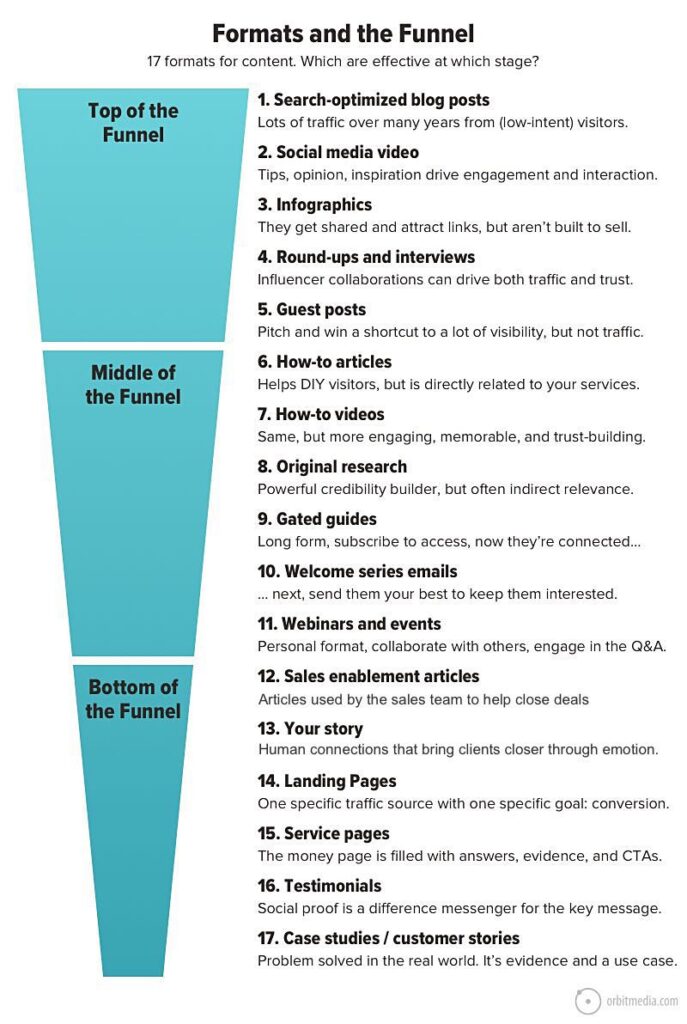By the end of the day, 7.5 million new blog posts will have been published. By the end of tomorrow, another 7.5 million, and so on (source). Here’s the kicker – 97% of those blogs will never be read (source).
That may be discouraging, but there’s a reason why 2.7 billion new blogs are published every year. The 3% that are engaged with are valuable, and potentially a consistent source of long-term, free, quality leads. In short, the juice is worth the squeeze.
The reality is, having a content strategy pays off. 71% of B2B buyers engage with blog content during their buying journey. Businesses that blog consistently generate 67% more leads than those that don’t. The juice, as they say, is definitely worth the squeeze (source).
Of course, blogging is just one piece of the content marketing puzzle. Some businesses might find greater success with short-form video, while others might focus on creating in-depth eBooks designed to capture leads. How you produce your content should be based on ways that best communicate your idea or showcase your product. Also keep in mind how your buyer likes to consume content. An e-commerce clothing company showcases their products differently than a manufacturing company, because they have different audiences.
To maximize your likelihood of success, it’s helpful to first understand the common pitfalls businesses make with their content strategy. The Content Marketing Institute surveyed nearly 1,000 B2B marketers and found that ineffective content marketing often stems from:
- A lack of clear goals
- A disconnect with the customer journey
- An absence of data
Let’s take a look at some ways to avoid these pitfalls.
1. A lack of clear goals → Define your content mission statement
Just like your business needs a mission statement, your content strategy needs a clearly defined purpose. Ask yourself, “What’s the job your content is hired to do?” You can also use this simple, yet effective template to define the mission of your content:
Our content is where [audience x] gets [information y] that offers [benefit z].
This should be the guiding principle for every piece of content you create. There is power in specificity. Establish yourself as the go-to source in a particular niche. Here are some examples of content mission statements in action.
- Tellabs: “The best source for info on optical LANs. We show IT buyers how to address tech and business challenges, identify trends, reduce expenses and improve user experiences.”
- Orbit Media: “The Orbit blog is where digital marketers find practical advice on content marketing, AI, Google Analytics 4 and web design. Our goal is to help you get better results from the web.”
- Wild Plum: “The Wild Plum blog is where non-marketing business leaders get relevant marketing trends and insights that they can incorporate into their business strategy to grow their online footprint.”
2. A disconnect with the customer journey → Determine where your potential customers would benefit most from your expertise
Where in the buying process can your content make the biggest impact? Realistically, most businesses don’t have unlimited resources. You can’t be everywhere at once. Trying to publish consistent, quality short-form video, original research, weekly blogs, infographics, etc., is not possible for most businesses who don’t have a team to carry the load.
For business owners who have one content person, or if you yourself are the sole content producer, my advice is, pick one content type. Choose a content type that aligns with your audience’s needs and your business goals, and importantly, promote it where your audience is, whether it be with search ads, social media ads, or some other channel that amplifies your message to a new audience. How do you figure out which content types to invest in?

- Talk to your sales team (or even better, your customers): A great starting point is to tap into the wealth of knowledge your sales team possesses. They’re on the front lines, interacting with potential customers daily. Find out what recurring pain points prospects have, or what questions they have about your product/service. Ask for insights about what current customers love about your product/service too. Your content should proactively answer these questions, positioning you as a helpful resource and building trust with potential buyers.
- Analyze your competitors: What are they doing well? What are they neglecting? If a competitor’s content is performing well, it signals a demand for that sort of information. Consider creating something similar, but even better. Conversely, if you notice a gap in their content strategy, that might be an opportunity for you to fill. Perhaps none of them are very active on LinkedIn or none have well-developed case studies. That may be an area to focus on.
3. Data Visibility
Data is the lifeblood of effective marketing. Without it, you’re simply guessing. Establish a foundation with a free website analytics tool like Google Analytics to gain visibility into your website traffic patterns and referral sources. If you have a CRM, take things a step further by integrating your marketing and CRM platforms, where you’ll unlock the power of unified data. This allows you to create automated workflows that respond to customer behavior, such as sending personalized follow-up emails triggered by their specific actions. You can also automate lead scoring and routing, ensuring a smooth transition of qualified leads to your sales team.
Parting Words
Quality, consistency, and patience. These are the three virtues of content strategy. Produce QUALITY content that displays your expertise and adds value to your audience. Publish this quality content with CONSISTENCY. The search engines love consistently published content, even if you’re updating and republishing old content. Lastly, remember PATIENCE. You won’t see results overnight, but if you stick with it, you’ll find that a well-executed content strategy is worth the effort.
About Matt Fraga

Matt Fraga is a UX/UI designer and marketing specialist passionate about creating impactful, user-focused experiences that deliver measurable business results. He’s managed digital marketing accounts for multi-million dollar companies across a multitude of industries, and currently does freelance digital marketing and web design. Put simply, Matt prides himself on creating websites and digital experiences that drive revenue.
Connect with Matt on LinkedIn.